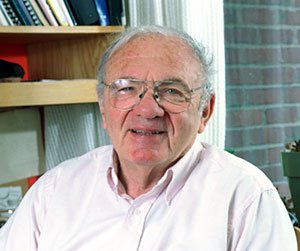Jack Strominger
A paper from the Strominger lab sheds interesting new light on the regulation of maturation of dendritic cells. (Santambrogio, L., et al., “Involvement of caspase cleaved and intact adaptor protein 1 complex in endosomal remodeling in maturing dendritic cells.” Nature Immunology; published online Sept. 18, in print October 2005, issue.) Dendritic cells are the primary antigen presenting lymphocytes in the immune system and their maturation plays a critical role in responding to foreign antigens derived from invading pathogens.
Dendritic cells as they exist in the skin, for example, are immature resting cells. On contact with foreign antigens, however, they rapidly mature and migrate to regional lymph nodes where immune responses are initiated. The major antigen presenting molecules on dendritic cells (those molecules that directly engage the antigens) are Class II major histocompatibility complex (MHC) proteins. They exist on resting dendritic cells only as “empty” proteins, but on maturation they become filled with peptides and then egress to the cell surface for antigen presentation. To do battle with antigens, they must first get to the cell surface; molecular transport within the cell is thus a key factor in cellular response.
The cells’ immature state is characterized by the cleavage of a moderate number of intracellular proteins by caspase-3. These cleavages inhibit many intracellular transport processes and lead to the dormant state. Caspase-3 is inactivated by nitric oxide generated by nitric oxide synthetase, which in turn is induced by lipopolysaccharide (LPS) and other agents. This allows the cell transport to proceed; in vitro cell maturation can be induced by bacterial LPS and other agents.
One of the molecules cleaved by caspase-3 is AP-1, an important heterotetramer involved in some intracellular transport processes that are not well defined. Cleavage of AP-1 was mimicked by mutations in the hinge regions of the b- and g- subunits of AP-1 that remove their ear domains. This transfected mutant together with RNAi-mediated knock down of endogenous AP-1 was used to elucidate an important function of AP-1 that was previously not known. During maturation tubulovesicular structures are formed through which peptide loaded MHCII proteins egress to the cell surface. Other proteins however must be retained in the endosomes. With the transfected mutant, however, some of these proteins reach the surface anomalously. Thus, intact AP-1 has an important function in retaining some proteins that should not be allowed to egress through the tubulovesicvular structures.
For more on this topic, see Dendritic cells: caspases keep them young (in News & Views, same issue of Nature Immunology) and Wong, S. H., Santambrogio, L and Strominger, J. L. Caspases and Nitric Oxide Broadly Regulate Dendritic Cell Maturation and Surface Expression of Class II MHC Proteins. Proc Natl Acad Sci USA. 101, 1783-88 (2004).


